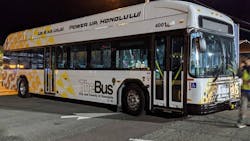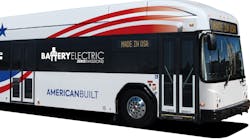Honolulu's TheBus unveils first electric bus
The City and County of Honolulu Department of Transportation Services (DTS) unveils its first battery-electric bus and kicks off the transition of TheBus fleet to zero-emission buses.
This first bus is a 40-foot GILLIG Zero-Emission Battery Electric bus with a 38-passenger seating capacity. It is one of three buses funded by a FY2020 Low-No Emissions Bus Program grant award from the Federal Transit Administration. The city partnered with GILLIG, the Center for Transportation and the Environment (CTE) based in Atlanta, Ga., and Hawaiian Electric Company on this grant project.
“Our administration set a bold goal to transform our public bus fleet to 100 percent renewable fuel by 2035 and we are now steps closer to achieving it,” said Honolulu Mayor Kirk Caldwell. The DTS has purchased an additional 16 new electric buses this year and expects to take delivery of the vehicles through 2021. The transition of TheBus fleet decreases greenhouse gas pollution, while reducing reliance on imported crude oil.
Electric buses bring a number of other benefits. “Electric buses provide a comfortable and smooth ride for our passengers. Residents will appreciate the quietness of this bus as it traverses Oʻahu’s neighborhoods,” said DTS Acting Director Jon Nouchi. “Also, our bus drivers will love the quick acceleration, agility, and new technology present on this newest member of our TheBus fleet.”
All new electric buses will feature a new livery designed in-house by DTS Deputy Director Dre Kalili.
“We want our new buses to look and feel both modern and local,” she explained. “We kept the familiar tri-color used on most of TheBus fleet, but created a design inspired by ‘ohe kāpala (Hawaiian bamboo stamping).”
In a few weeks, this electric bus will be deployed on routes that are based at the Kalihi-Pālama Bus Facility.






